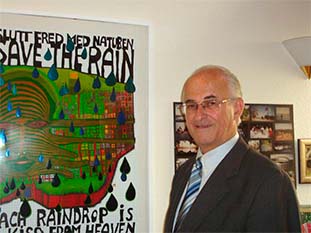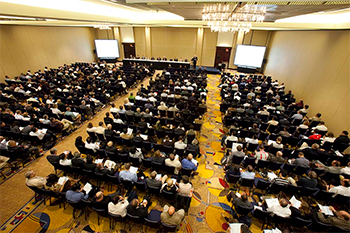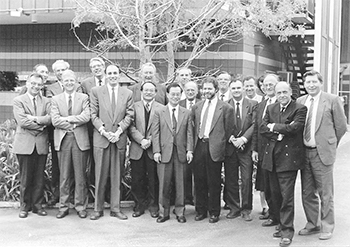IAHR Talks | Interview with Prof. Helmut Kobus. Focus on IAHR History
#IAHRTalks
 Professor Helmut Kobus, President of IAHR from 1995 to 1999, Honorary Member of IAHR, and member of the IAHR technical committee on Groundwater Hydraulics and Management, shares with us his views about the history of the association, the interrelation among consulting engineers, governmental representatives, and researchers throughout the IAHR network, the scientific milestones that have had the greatest effect on IAHR, and the most critical challenges the association will have to face over the next 85 years.
Professor Helmut Kobus, President of IAHR from 1995 to 1999, Honorary Member of IAHR, and member of the IAHR technical committee on Groundwater Hydraulics and Management, shares with us his views about the history of the association, the interrelation among consulting engineers, governmental representatives, and researchers throughout the IAHR network, the scientific milestones that have had the greatest effect on IAHR, and the most critical challenges the association will have to face over the next 85 years.
David Ferras, vice-chair of the IAHR technical committee on education and professional development, interviews Prof. Kobus.
When and why did you first get involved with IAHR?
I had my first contact with IAHR between 1961 and 1965 when I was a graduate student in the USA at the Iowa Institute of Hydraulic Research. After graduation in 1965, Prof. Hunter Rouse advised me that joining IAHR would help me to keep up with my career as researcher. So I joined the association as did many of my fellow students from all over the world, and some had long and successful careers through IAHR.
In your article “A brief reflection on the history of IAHR” (Hydrolink 2020-3) you stated that Hunter Rouse was a convincing promoter of IAHR. Can you recall why he was so convincing? Would his arguments still be valid to the current young professionals?
Hunter Rouse was the leading hydraulician of his time, with a broad international background. As an American he earned a doctoral degree in Germany, and later became director of the Iowa Institute of Hydraulic Research. He wrote excellent textbooks, and his classes were not just lectures but rather discussions with the students. He used to start the lecture by asking us, the students, if we had any questions. If not, then he had some for us. So we used to make sure we had good questions before starting the lecture! He also knew how to secure our jobs as research assistants, providing us with the right framework to develop our work, and involving us in practical engineering projects. His personal attention and care for the international students and his reputation were a great source of motivation for us. He convinced us that fluid dynamics and water research are global tasks. He was a strong supporter of IAHR involving the staff in the IAHR major congresses.
All these convincing arguments are still valid nowadays. I can give the example of Stuttgart, where in 1999, we started a bilingual international MSc programme in Water Resources Engineering and Management and subsequently also a Doctoral programme in Environment and Water. We formed the first of the IAHR student chapters, which now are called Young Professionals Networks (YPNs). This idea led to the current 47 YPNs which span over 21 different countries. The direct interaction with the students, leading them into the international world is what makes the difference.
In your opinion, what are the scientific milestones of the 20th century that have had the greatest effect on IAHR in the 21st century?
I was the last IAHR president of the last century. During the last century IAHR saw continuous growth on a truly global scale. In my opinion I would like to highlight four major milestones:
The connection of hydraulic research and its application with the inclusion of professional issues and engineering practice in IAHR activities;
Broadening the scope towards water resources management, including ecological, economic, and societal aspects;
Hydroinformatics has been a revolution in our field. From physical to numerical models, including modern tools of field measurements, remote sensing, artificial intelligence, etc., it has opened up completely new approaches and solutions. Moreover, it has brought a new basis for interdisciplinary cooperation.
The involvement of continuing education and professional development.
The first two aspects led IAHR to change its name from “International Association for Hydraulics Research” to the “International Association for Hydro-Environment Engineering and Research.”
The technical committee on Education and Professional Development was formed in 1995 based on the work of a task group that you headed for several years. This committee seeks to enhance knowledge transfer not only from generation to generation but also from researchers to practitioners. What have been the achievements of the committee and, with respect to IAHR, in getting closer to engineering practice? Which is the current status of the interrelation among consulting engineers, governmental representatives, and researchers throughout the IAHR network and what should be strengthened?
 The knowledge transfer from research to practice happens primarily though our members who at their institutes are involved in water projects and the development of new technologies. This is essential in the water profession. Our congresses traditionally focus on the progress of research and less on this transfer of knowledge. The role of Hydrolink articles in communicating new engineering practices is important and could even be strengthened. Collaboration with regional or national associations which have a main focus on engineering practice might also be enhanced, not necessarily in our biennial World Congresses, but in the Regional Congresses or in many other IAHR events. The growing potential of the Young Professionals Networks will also contribute to strengthening the links with engineering practice in the long term.
The knowledge transfer from research to practice happens primarily though our members who at their institutes are involved in water projects and the development of new technologies. This is essential in the water profession. Our congresses traditionally focus on the progress of research and less on this transfer of knowledge. The role of Hydrolink articles in communicating new engineering practices is important and could even be strengthened. Collaboration with regional or national associations which have a main focus on engineering practice might also be enhanced, not necessarily in our biennial World Congresses, but in the Regional Congresses or in many other IAHR events. The growing potential of the Young Professionals Networks will also contribute to strengthening the links with engineering practice in the long term.
What is the role of IAHR concerning the lifelong learning of its affiliates? For instance, recently the 1st IAHR Congress for Young Professionals was held online. One of its aims was to connect juniors with seniors. From the EPD committee we would like to continue fostering such linkages through webinars, workshops, and organising the Congress for Young Professionals on an annual basis. Are we going beyond IAHR’s scope and getting into the business of higher education institutions? What’s the right compromise?
The YPN network provides a good basis to enrich and broaden the education taking place in the universities because it teaches students about the global dimension of our profession. We need to look at this complementarity, without interfering with the university education process; e.g. students should not earn ECTS credits directly from our activities, which have to be seen as an addition to the standard education. When working on the European Graduate School Water (IAHR-EGW), we learned quickly that the right compromise was to focus on our summer schools, workshops, excursions, etc. Concerning the 1st online Congress for Young Professionals, I think this is a great way of opening a door to the young generation to have a first international experience, exposing their work in front of an international audience. It is a good training ground, but we must be careful not to make the mistake of sectoring juniors from seniors. The World Congress has to be inclusive for the juniors too. If we organize a specific congress for young professionals, we must ensure that this does not lead to a decrease in participation of the young professionals in the World Congress.
Also, we shouldn’t neglect the added value of face-to-face congresses. The modern online communication tools have provided a big help for our global network this year and will do so as well in the future. But we must not miss out on the added value of face-to-face meetings. IAHR congresses with personal contacts and discussions and common experiences involving mutual esteem, sympathy, and friendship among the participants are an important element of our global network, as I have experienced it for the past half a century.
This year IAHR is turning 85, what do you think are the most critical challenges the association will have to face over the next 85 years?
 On the global agenda water has become an important item; our international network of engaged professionals will have to tackle big challenges. Interdisciplinary cooperation with other associations, such as IWA, and modern tools, such as the ones provided by Hydroinformatics, will help to overcome these challenges. I would like to point out three of the most critical challenges:
On the global agenda water has become an important item; our international network of engaged professionals will have to tackle big challenges. Interdisciplinary cooperation with other associations, such as IWA, and modern tools, such as the ones provided by Hydroinformatics, will help to overcome these challenges. I would like to point out three of the most critical challenges:
Global water security and global water supply for everybody: international attention is needed particularly in critical areas of the world; for instance in Africa, which has recently come into the focus of IAHR.
Climate change: global warming has big effects on water resources and hydrology. For this, the cooperation with other associations will be crucial.
The hydro-environment will continue to face many problems on many fronts, namely in the areas of water quality, sediments, agriculture, or nature-based solutions.
Our members, their views, knowledge, commitment, and experiences are what make IAHR a global leading association of hydro-environmental engineers, experts, researchers, and organisations. IAHR members’ voices and concerns guide the association on its continuing path towards a better future for water and the environment. Our members have a lot to contribute and we are listening to them so that we can put our collective voice forward.